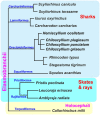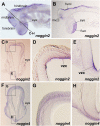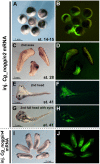Loss of noggin1, a classic embryonic inducer gene, in elasmobranchs
- PMID: 38360907
- PMCID: PMC10869764
- DOI: 10.1038/s41598-024-54435-9
Loss of noggin1, a classic embryonic inducer gene, in elasmobranchs
Abstract
Secreted proteins of the Noggin family serve as pivotal regulators of early development and cell differentiation in all multicellular animals, including vertebrates. Noggin1 was identified first among all Noggins. Moreover, it was described as the first known embryonic inducer specifically secreted by the Spemann organizer and capable of inducing a secondary body axis when expressed ectopically. In the classical default model of neural induction, Noggin1 is presented as an antagonist of BMP signalling, playing a role as a neural inducer. Additionally, Noggin1 is involved in the dorsalization of embryonic mesoderm and later controls the differentiation of various tissues, including muscles, bones, and neural crest derivatives. Hitherto, noggin1 was found in all studied vertebrates. Here, we report the loss of noggin1 in elasmobranchs (sharks, rays and skates), which is a unique case among vertebrates. noggin2 and noggin4 retained in this group and studied in the embryos of the grey bamboo shark Chiloscyllium griseum revealed similarities in expression patterns and functional properties with their orthologues described in other vertebrates. The loss of noggin1 in elasmobranchs may be associated with histological features of the formation of their unique internal cartilaginous skeleton, although additional research is required to establish functional connections between these events.
© 2024. The Author(s).
Conflict of interest statement
The authors declare no competing interests.
Figures






Similar articles
-
Multiple noggins in vertebrate genome: cloning and expression of noggin2 and noggin4 in Xenopus laevis.Gene Expr Patterns. 2006 Jan;6(2):180-6. doi: 10.1016/j.modgep.2005.06.007. Epub 2005 Sep 15. Gene Expr Patterns. 2006. PMID: 16168719
-
Discovery of four Noggin genes in lampreys suggests two rounds of ancient genome duplication.Commun Biol. 2020 Sep 10;3(1):501. doi: 10.1038/s42003-020-01234-3. Commun Biol. 2020. PMID: 32913324 Free PMC article.
-
Expression of Xenopus tropicalis noggin1 and noggin2 in early development: two noggin genes in a tetrapod.Gene Expr Patterns. 2004 Dec;5(2):225-30. doi: 10.1016/j.modgep.2004.08.001. Gene Expr Patterns. 2004. PMID: 15567718
-
The choice between epidermal and neural fate: a matter of calcium.Int J Dev Biol. 2004;48(2-3):75-84. doi: 10.1387/ijdb.15272372. Int J Dev Biol. 2004. PMID: 15272372 Review.
-
Big insight from the little skate: Leucoraja erinacea as a developmental model system.Curr Top Dev Biol. 2022;147:595-630. doi: 10.1016/bs.ctdb.2021.12.016. Epub 2022 Feb 28. Curr Top Dev Biol. 2022. PMID: 35337464 Review.
References
-
- Seixas MJ, Domingues RR, Antunes A. Decoding the transcriptome of sharks, rays, and chimaeras: Insights into their physiology, morphology, evolution, and biomedical applications. Fishes. 2023;8:271. doi: 10.3390/fishes8050271. - DOI
-
- White WT, O’Neill HL, Naylor GJP. Taxonomy and diversity of extant elasmobranchs. In: Carrier JC, Simpfendorfer CA, Heithaus MR, Yopak KE, editors. Biology of Sharks and Their Relatives. CRC Press; 2022. pp. 31–57.
Publication types
MeSH terms
Substances
Grants and funding
LinkOut - more resources
Full Text Sources

